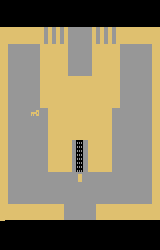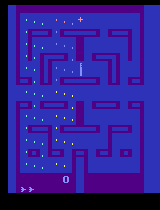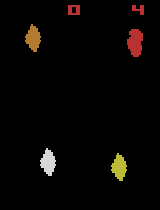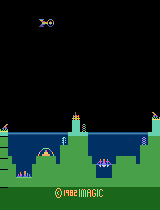Atari#
A set of Atari 2600 environments simulated through Stella and the Arcade Learning Environment.
Atari environments are simulated via the Arcade Learning Environment (ALE) [1] through the Stella emulator.
AutoROM (installing the ROMs)#
ALE-py doesn’t include the atari ROMs (pip install gymnasium[atari]) which are necessary to make any of the atari environments.
To install the atari ROM, use pip install gymnasium[accept-rom-license] which will install AutoROM and download the ROMs, install them in the default location.
In doing so, you agree to own a license to these Atari 2600 ROMs and agree to not distribution these ROMS.
It is possible to install the ROMs in an alternative location, AutoROM has more information.
Action Space#
Each environment will use a sub-set of the full action space listed below:
Value |
Meaning |
Value |
Meaning |
Value |
Meaning |
|---|---|---|---|---|---|
|
|
|
|
|
|
|
|
|
|
|
|
|
|
|
|
|
|
|
|
|
|
|
|
|
|
|
|
|
|
|
|
|
|
|
|
By default, most environments use a smaller subset of the legal actions excluding any actions that don’t have an effect in the game.
If users are interested in using all possible actions, pass the keyword argument full_action_space=True to gymnasium.make.
Observation Space#
The Atari environments observation can be
The RGB image that is displayed to a human player using
obs_type="rgb"with observation spaceBox(0, 255, (210, 160, 3), np.uint8)The grayscale version of the RGB image using
obs_type="grayscale"with observation spaceBox(0, 255, (210, 160), np.uint8)The RAM state (128 bytes) from the console using
obs_type="ram"with observation spaceBox(0, 255, (128), np.uint8)
Rewards#
The exact reward dynamics depend on the environment and are usually documented in the game’s manual. You can find these manuals on AtariAge.
Stochasticity#
As the Atari games are entirely deterministic, agents could achieve state-of-the-art performance by simply memorizing an optimal sequence of actions while completely ignoring observations from the environment.
To avoid this, there are several methods to avoid this.
Sticky actions: Instead of always simulating the action passed to the environment, there is a small probability that the previously executed action is used instead. In the v0 and v5 environments, the probability of repeating an action is
25%while in v4 environments, the probability is0%. Users can specify the repeat action probability usingrepeat_action_probabilitytomake.Frameskipping: On each environment step, the action can be repeated for a random number of frames. This behavior may be altered by setting the keyword argument
frameskipto either a positive integer or a tuple of two positive integers. Ifframeskipis an integer, frame skipping is deterministic, and in each step the action is repeatedframeskipmany times. Otherwise, ifframeskipis a tuple, the number of skipped frames is chosen uniformly at random betweenframeskip[0](inclusive) andframeskip[1](exclusive) in each environment step.
Common Arguments#
When initializing Atari environments via gymnasium.make, you may pass some additional arguments. These work for any
Atari environment.
mode:
int. Game mode, see [2]. Legal values depend on the environment and are listed in the table above.difficulty:
int. The difficulty of the game, see [2]. Legal values depend on the environment and are listed in the table above. Together withmode, this determines the “flavor” of the game.obs_type:
str. This argument determines what observations are returned by the environment. Its values are:“ram”: The 128 Bytes of RAM are returned
“rgb”: An RGB rendering of the game is returned
“grayscale”: A grayscale rendering is returned
frameskip:
intor a tuple of twoints. This argument controls stochastic frame skipping, as described in the section on stochasticity.repeat_action_probability:
float. The probability that an action is repeated, also called “sticky actions”, as described in the section on stochasticity.full_action_space:
bool. If set toTrue, the action space consists of all legal actions on the console. Otherwise, the action space will be reduced to a subset.render_mode:
str. Specifies the rendering mode. Its values are:human: Display the screen and enable game sounds. This will lock emulation to the ROMs specified FPS
rgb_array: Returns the current environment RGB frame of the environment.
Version History and Naming Schemes#
All Atari games are available in three versions. They differ in the default settings of the arguments above. The differences are listed in the following table:
Version |
|
|
|
|---|---|---|---|
v0 |
|
|
|
v4 |
|
|
|
v5 |
|
|
|
Version v5 follows the best practices outlined in [2]. Thus, it is recommended to transition to v5 and customize the environment using the arguments above, if necessary.
For each Atari game, several different configurations are registered in Gymnasium. The naming schemes are analogous for v0 and v4. Let us take a look at all variations of Amidar-v0 that are registered with gymnasium:
Name |
|
|
|
|---|---|---|---|
Amidar-v0 |
|
|
|
AmidarDeterministic-v0 |
|
|
|
AmidarNoframeskip-v0 |
|
|
|
Amidar-ram-v0 |
|
|
|
Amidar-ramDeterministic-v0 |
|
|
|
Amidar-ramNoframeskip-v0 |
|
|
|
Things change in v5: The suffixes “Deterministic” and “NoFrameskip” are no longer available. Instead, you must specify the
environment configuration via arguments passed to gymnasium.make. Moreover, the v5 environments
are in the “ALE” namespace. The suffix “-ram” is still available. Thus, we get the following table:
Name |
|
|
|
|---|---|---|---|
ALE/Amidar-v5 |
|
|
|
ALE/Amidar-ram-v5 |
|
|
|
Flavors#
Some games allow the user to set a difficulty level and a game mode. Different modes/difficulties may have different game dynamics and (if a reduced action space is used) different action spaces. We follow the convention of [2] and refer to the combination of difficulty level and game mode as a flavor of a game. The following table shows the available modes and difficulty levels for different Atari games:
Environment |
Possible Modes |
Default Mode |
Possible Difficulties |
Default Difficulty |
|---|---|---|---|---|
Adventure |
[0, 1, 2] |
0 |
[0, 1, 2, 3] |
0 |
AirRaid |
[1, …, 8] |
1 |
[0] |
0 |
Alien |
[0, 1, 2, 3] |
0 |
[0, 1, 2, 3] |
0 |
Amidar |
[0] |
0 |
[0, 3] |
0 |
Assault |
[0] |
0 |
[0] |
0 |
Asterix |
[0] |
0 |
[0] |
0 |
Asteroids |
[0, …, 31, 128] |
0 |
[0, 3] |
0 |
Atlantis |
[0, 1, 2, 3] |
0 |
[0] |
0 |
Atlantis2 |
[0] |
0 |
[0] |
0 |
Backgammon |
[0] |
0 |
[3] |
0 |
BankHeist |
[0, 4, 8, 12, 16, 20, 24, 28] |
0 |
[0, 1, 2, 3] |
0 |
BasicMath |
[5, 6, 7, 8] |
5 |
[0, 2, 3] |
0 |
BattleZone |
[1, 2, 3] |
1 |
[0] |
0 |
BeamRider |
[0] |
0 |
[0, 1] |
0 |
Berzerk |
[1, …, 9, 16, 17, 18] |
1 |
[0] |
0 |
Blackjack |
[0] |
0 |
[0, 1, 2, 3] |
0 |
Bowling |
[0, 2, 4] |
0 |
[0, 1] |
0 |
Boxing |
[0] |
0 |
[0, 1, 2, 3] |
0 |
Breakout |
[0, 4, 8, 12, 16, 20, 24, 28, 32, 36, 40, 44] |
0 |
[0, 1] |
0 |
Carnival |
[0] |
0 |
[0] |
0 |
Casino |
[0, 2, 3] |
0 |
[0, 1, 2, 3] |
0 |
Centipede |
[22, 86] |
22 |
[0] |
0 |
ChopperCommand |
[0, 2] |
0 |
[0, 1] |
0 |
CrazyClimber |
[0, 1, 2, 3] |
0 |
[0, 1] |
0 |
Crossbow |
[0, 2, 4, 6] |
0 |
[0, 1] |
0 |
Darkchambers |
[0] |
0 |
[0] |
0 |
Defender |
[1, …, 9, 16] |
1 |
[0, 1] |
0 |
DemonAttack |
[1, 3, 5, 7] |
1 |
[0, 1] |
0 |
DonkeyKong |
[0] |
0 |
[0] |
0 |
DoubleDunk |
[0, …, 15] |
0 |
[0] |
0 |
Earthworld |
[0] |
0 |
[0] |
0 |
ElevatorAction |
[0] |
0 |
[0] |
0 |
Enduro |
[0] |
0 |
[0] |
0 |
Entombed |
[0] |
0 |
[0, 2] |
0 |
Et |
[0, 1, 2] |
0 |
[0, 1, 2, 3] |
0 |
FishingDerby |
[0] |
0 |
[0, 1, 2, 3] |
0 |
FlagCapture |
[8, 9, 10] |
8 |
[0] |
0 |
Freeway |
[0, …, 7] |
0 |
[0, 1] |
0 |
Frogger |
[0, 1, 2] |
0 |
[0, 1] |
0 |
Frostbite |
[0, 2] |
0 |
[0] |
0 |
Galaxian |
[1, …, 9] |
1 |
[0, 1] |
0 |
Gopher |
[0, 2] |
0 |
[0, 1] |
0 |
Gravitar |
[0, 1, 2, 3, 4] |
0 |
[0] |
0 |
Hangman |
[0, 1, 2, 3] |
0 |
[0, 1] |
0 |
HauntedHouse |
[0, …, 8] |
0 |
[0, 1] |
0 |
Hero |
[0, 1, 2, 3, 4] |
0 |
[0] |
0 |
HumanCannonball |
[0, …, 7] |
0 |
[0, 1] |
0 |
IceHockey |
[0, 2] |
0 |
[0, 1, 2, 3] |
0 |
Jamesbond |
[0, 1] |
0 |
[0] |
0 |
JourneyEscape |
[0] |
0 |
[0, 1] |
0 |
Kaboom |
[0] |
0 |
[0] |
0 |
Kangaroo |
[0, 1] |
0 |
[0] |
0 |
KeystoneKapers |
[0] |
0 |
[0] |
0 |
KingKong |
[0, 1, 2, 3] |
0 |
[0] |
0 |
Klax |
[0, 1, 2] |
0 |
[0] |
0 |
Koolaid |
[0] |
0 |
[0] |
0 |
Krull |
[0] |
0 |
[0] |
0 |
KungFuMaster |
[0] |
0 |
[0] |
0 |
LaserGates |
[0] |
0 |
[0] |
0 |
LostLuggage |
[0, 1] |
0 |
[0, 1] |
0 |
MarioBros |
[0, 2, 4, 6] |
0 |
[0] |
0 |
MiniatureGolf |
[0] |
0 |
[0, 1] |
0 |
MontezumaRevenge |
[0] |
0 |
[0] |
0 |
MrDo |
[0, 1, 2, 3] |
0 |
[0] |
0 |
MsPacman |
[0, 1, 2, 3] |
0 |
[0] |
0 |
NameThisGame |
[8, 24, 40] |
8 |
[0, 1] |
0 |
Othello |
[0, 1, 2] |
0 |
[0, 2] |
0 |
Pacman |
[0, …, 7] |
0 |
[0, 1] |
0 |
Phoenix |
[0] |
0 |
[0] |
0 |
Pitfall |
[0] |
0 |
[0] |
0 |
Pitfall2 |
[0] |
0 |
[0] |
0 |
Pong |
[0, 1] |
0 |
[0, 1, 2, 3] |
0 |
Pooyan |
[10, 30, 50, 70] |
10 |
[0] |
0 |
PrivateEye |
[0, 1, 2, 3, 4] |
0 |
[0, 1, 2, 3] |
0 |
Qbert |
[0] |
0 |
[0, 1] |
0 |
Riverraid |
[0] |
0 |
[0, 1] |
0 |
RoadRunner |
[0] |
0 |
[0] |
0 |
Robotank |
[0] |
0 |
[0] |
0 |
Seaquest |
[0] |
0 |
[0, 1] |
0 |
SirLancelot |
[0] |
0 |
[0] |
0 |
Skiing |
[0] |
0 |
[0] |
0 |
Solaris |
[0] |
0 |
[0] |
0 |
SpaceInvaders |
[0, …, 15] |
0 |
[0, 1] |
0 |
SpaceWar |
[6, …, 17] |
6 |
[0] |
0 |
StarGunner |
[0, 1, 2, 3] |
0 |
[0] |
0 |
Superman |
[0] |
0 |
[0, 1, 2, 3] |
0 |
Surround |
[0, 2] |
0 |
[0, 1, 2, 3] |
0 |
Tennis |
[0, 2] |
0 |
[0, 1, 2, 3] |
0 |
Tetris |
[0] |
0 |
[0] |
0 |
TicTacToe3D |
[0, …, 8] |
0 |
[0, 2] |
0 |
TimePilot |
[0] |
0 |
[0, 1, 2] |
0 |
Trondead |
[0] |
0 |
[0, 1] |
0 |
Turmoil |
[0, …, 8] |
0 |
[0] |
0 |
Tutankham |
[0, 4, 8, 12] |
0 |
[0] |
0 |
UpNDown |
[0] |
0 |
[0, 1, 2, 3] |
0 |
Venture |
[0] |
0 |
[0, 1, 2, 3] |
0 |
VideoCheckers |
[1, …, 9, 11, …, 19] |
1 |
[0] |
0 |
VideoChess |
[0, 1, 2, 3, 4] |
0 |
[0] |
0 |
VideoCube |
[0, 1, 2, 100, 101, 102, …, 5000, 5001, 5002] |
0 |
[0, 1] |
0 |
VideoPinball |
[0, 2] |
0 |
[0, 1] |
0 |
WizardOfWor |
[0] |
0 |
[0, 1] |
0 |
WordZapper |
[0, …, 23] |
0 |
[0, 1, 2, 3] |
0 |
YarsRevenge |
[0, 32, 64, 96] |
0 |
[0, 1] |
0 |
Zaxxon |
[0, 8, 16, 24] |
0 |
[0] |
0 |
References#
[1] MG Bellemare, Y Naddaf, J Veness, and M Bowling. “The arcade learning environment: An evaluation platform for general agents.” Journal of Artificial Intelligence Research (2012).
[2] Machado et al. “Revisiting the Arcade Learning Environment: Evaluation Protocols and Open Problems for General Agents” Journal of Artificial Intelligence Research (2018) URL: https://jair.org/index.php/jair/article/view/11182










